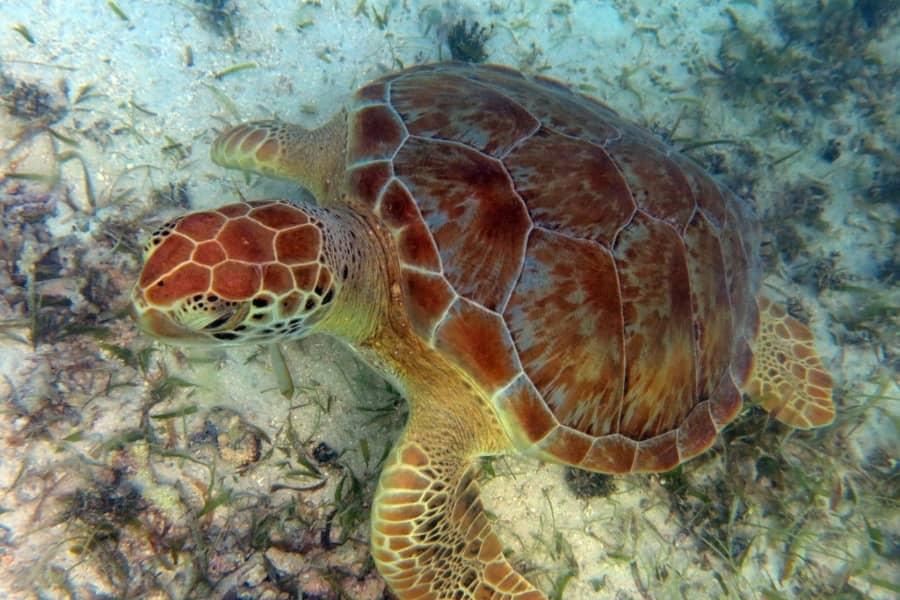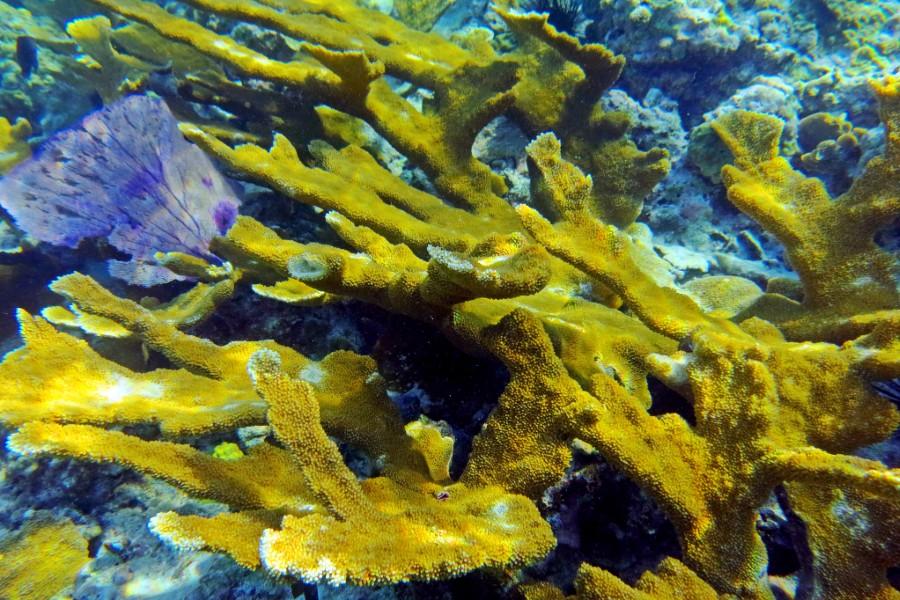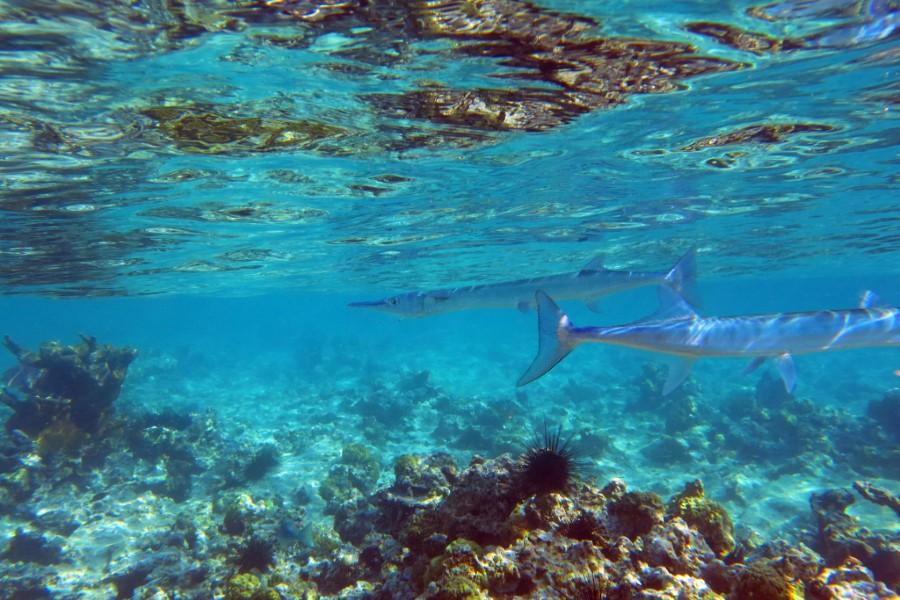Snorkeling the waters of St. John, U.S. Virgin Islands, is one of the most rewarding and exciting things to do on St. John. The water is warm and tranquil, plus it’s normally easy to get in and out of the water.
You move effortlessly, unencumbered by gravity, and experience the wonderful and colorful world of the coral reefs, seagrass beds, and mangrove lagoons that surround the Virgin Islands National Park.
Knowing the correct snorkeling techniques, understanding the St. John’s undersea environment, and being able to identify and know about what you will see in this strange new world can greatly enhance your enjoyment of the sport, as well as alert you to any possible safety or environmental concerns. Here are our recommendations on the best places to snorkel in St. John.
Maho Bay
Maho Bay offers a wonderful seagrass environment with plenty of sea turtles. Maho is the best bay on St. John for observing the inhabitants of this important environment, including rays, conch, and starfish, in a calm environment.

It’s perfect for beginner snorkelers and children. Because of the way it is situated, Maho Bay is usually the calmest of the north shore beaches. Moreover, the water deepens gradually and stays relatively shallow as you wade out from the beach. These factors make Maho Bay the perfect starting place for children and those just learning to snorkel.

Maho Bay also offers good reef snorkeling for those looking to explore the sea life on a coral reef. The best area for this is along the coast on the northern side of the bay and out to the big rocks at Maho Point. Whether you stay in Cruz Bay or Coral Bay, you need to visit Maho Bay Beach as it arguably offers the best snorkeling in St John.
Salomon Bay

Some of the finest snorkeling on the north shore area of the Virgin Islands National Park can be found on the reef between Salomon Bay and Honeymoon Beach. This easily accessible, shallow-water snorkel can be thoroughly enjoyed by snorkelers of all experience levels.
Both beaches can be reached via the Lind Point Trail or from the Caneel Bay Resort. Snorkeling equipment, as well as single and double kayaks, standup paddle boards, and beach chairs can be rented at the Honeymoon Beach Hut.
Most of the reef lies in calm shallow water, with some sections even rising above the surface at times of extreme low tides. Thus, snorkelers should make an extra effort to avoid situations where the water is too shallow for them.
The coral reef here is in relatively good condition, and the reef community is colorful and diverse. Snorkelers can encounter intricate coral formations and lots of marine life, with different varieties arriving at different times of the day.

Snorkeling in the center of the bay can also be a worthwhile experience. Stay in areas protected by swim buoys to minimize danger from dinghy traffic in the area. Here, the environment is sand and coral rubble. The hills and holes on the sea floor are formed by eels, worms, shrimp, clams, and crabs that make their homes on this underwater beach. If you’re lucky, you might also catch sight of some sea turtles.
The reef on the east end of Honeymoon Beach, around the point between Caneel Bays, is also a good snorkeling area. It’s closer to the beach and smaller than the more extensive reef on the other side of the bay.
Salt Pond Bay

There’s a beautiful reef located just about in the center of Salt Pond Bay, where two sets of rocks rise above the surface of the water. Near the left side of the reef, you can find a vibrant pillar coral that always seems to be a big attraction for colorful little fish.
Be aware that it is a somewhat long snorkel to reach the reef and that the sea is often choppy at times, causing waves to break over the rocks. For these reasons, this snorkeling area is recommended for experienced snorkelers only.

For some reason, this beautiful beach always rewards me with something exciting. Among other cool stuff, I’ve seen moray eels, turtles, nurse sharks, and squid. You’ll also find plenty of reef fish, corals, sea fans, and sponges.
Snorkeling out along the east side of the bay, you can reach the coral reefs that lie just north of Blue Cobblestone Beach. This is a considerable distance also, so pace yourself, or to decrease the distance, take the Ram Head Trail to the beach and snorkel towards Salt Pond Bay.
Tektike Bay
The Tektite snorkel is one of the absolute best snorkeling spots on St. John, and contrary to popular belief, it can be accessed by land with relative ease. The name, Tektite, refers to a research project conducted at Beehive Bay, a small cove on the southeastern tip of Great Lameshur Bay.

Getting there is part of the fun. The first step is to get to Great Lameshur Bay on St. John’s south coast. Take Salt Pond Road (Route 107) past Salt Pond Bay. The road heads west and goes up and then down a steep hill. Great Lameshur Bay lies at the bottom of the hill. Park near the big tamarind tree at the entrance to this large cobblestone beach.
Walk to the eastern end of the beach. A quarter-mile hike and rock scramble along the western shore of Cabritte Horn Point will take you to a remote and isolated coral rubble and sand beach called Donkey Bight. This bay, an inner bay of Great Lameshur, lies just to the north of Beehive Cove, the bay where the Tektite project took place.
Put on your gear and enter the water from the sand on the southern end of the beach. Beehive Cove lies on the other side of the small rocky point to the south.
You will be snorkeling in a location that is somewhat far away from a convenient place to get out of the water, and there may be areas of rough seas. For a full appreciation of this area, one should also have the ability to free dive in order to investigate the environments under ledges, beneath coral heads, and within caves and tunnels. Snorkeling is best on calm days when there is good visibility underwater.
The best snorkeling area can be found as you approach Beehive Cove, as everything becomes more colorful. On the north side of the point, there is a small cave with an exit to the surface. The walls and ceiling of the cave are covered with beautiful cup corals and sponges. As you snorkel around the point, or headland, which defines Beehive Bay, you can see a line of large rocks, which seems to attract a good share of marine life.

On the Beehive Cove side of the point, the water gets deeper. There are two rooms or chambers with rock walls on three sides. The second room is the most interesting, although both are beautiful. The eastern wall of the second room is encrusted with sponges and cup coral.
Because there is low light within the room, some of the coral animals may have their tentacles extended as if it were night on the reef. The thin yellow tentacles protruding from the small bright orange cups make the corals look like flowers.
Leinster Bay

Leinster Bay is made up of two smaller bays, Waterlemon Cay on the east and Mary’s Creek on the west. To reach Waterlemon Bay, which has two great snorkeling locations, take the Leinster Bay Trail, beginning at the parking area for the Annaberg Sugar Mill Ruins.
About halfway (0.4 miles) down the Leinster Bay Trail lies a small sand and coral rubble beach, which provides excellent snorkeling for intermediate and advanced snorkelers. This is the first and only sandy beach that you pass on the trail before arriving at the beautiful beach across from Waterlemon Cay.
Enter the water over a shallow area of coral rubble. It’s a relatively easy entry, but be careful where you step while putting on your gear to avoid contact with any sea urchins or live coral.
The reef extends out about 20 yards from shore. It’s shallow over the top of the reef but deep enough for experienced and confident snorkelers to negotiate safely. Care should be taken not to kick the coral with your fins.
At the seaside edge of the reef is an underwater hillside, which descends about 30 feet to meet the sand and grass bottom of the center portion of the bay. A good plan is to snorkel west (to the left) over the shallow portion of the reef first and then return along the deeper reef edge.

The dominant species of coral found in the shallow top reef are colonies of star and boulder coral. When snorkeling in St John, you will often find small reef fish near the coral. You can see parrotfish, angelfish, grunts, damselfish, and schools of blue tang, along with a vast assortment of invertebrates such as sponges and plume worms.
Along the reef edge on the underwater hillside are gardens of sea fans and other gorgonians, such as sea rods, sea plumes, dead man’s fingers, and sea whips. This section of the reef tends to attract larger predators such as blue runners, mutton snapper, and yellowtail snapper.
There can be a moderate current here which sets to the west, as well as the possibility of a strong breeze blowing in the same direction. Be prepared for a more difficult return to the beach, as you will be going against the chop and the current.
Francis Bay
The rocky north coast on the right-hand side of the beach offers excellent snorkeling, especially during the summer months when large schools of fry congregate close to shore. These small silvery fish travel in close proximity to one another in large schools that look like moving underwater shadows.

On the outskirts of these living clouds, in slightly deeper water, lurk predators, such as jacks, yellowtail snapper, Spanish mackerel, and barracuda as well some respectfully-sized tarpon and pompano.
Every now and then, one of these larger fish will enter to feed, moving quickly into the glittery mass. The fry is extremely sensitive to minute changes in water currents and can sense the approach of the hunters.
In the midst of all this activity, large schools of French grunts, oblivious to the drama around them, hover, almost motionless, over and around colorful live coral. Parrotfish and blue tang swim about grazing on algae.

Little damselfish defend their self-proclaimed territories by darting menacingly at even large intruders.
A closer look will reveal all sorts of beautiful and mysterious sea creatures that live in Francis Bay Beach, like small eels, feather dusters and Christmas tree worms, brightly colored sponges, and gracefully swaying gorgonians such as the colorful sea fan.
In the underwater grasslands just seaward of the reef, snorkelers are likely to come upon large green sea turtles, often accompanied by stuck-on remora or bar jacks that follow along just inches above the turtle’s back. In this area, one may also see southern stingrays, conch, trunkfish, and others.
Haulover Bay South

Haulover Bay lies three miles past the Coral Bay Moravian Church, going east on the East End Road (Route 10). Park on the south side of the road alongside the small sand and coral rubble beach.
Haulover is a narrow, flat strip of land separating Coral Bay on the south from Sir Francis Drake Channel on the north. The name Haulover came about because it was often easier to just “haul” small boats over this stretch of land than to make the long sail around East End, notorious for strong currents, gusty winds, and rough seas.
The southern side of Haulover Bay, St John, lies just off the side of Route 10. This beautiful bay was featured in the movie Big Blue. The southern bay is calmer than its counterpart in the north, has an easier entry, and is more suitable for beginners and intermediate snorkelers.
Snorkel along the western shore toward the point and around the offshore rocks called the blinders. Sea cucumbers are particularly plentiful here. Soft starfish, red sea urchins, and bristle worms can be seen under the rocks in shallow areas.
Haulover Bay North

The Northwestern Side
To reach the northwestern section of Haulover Bay, take the trail on the other (north) side of the road. It’s an easy path about 100 yards long that goes over flat terrain, passing by a small salt pond about halfway along the trail.
On most days, waves break along the shoreline and over the shallow reef, so try to choose a day when the sea is calm, and the water is not churned up.
You can enter the water at the rock beach at the end of the trail. The water is shallow at first, and the bottom is made up of small rocks and coral rubble. Watch out for black spiny sea urchins hiding here.
The reef rises up close to the surface near the shore and then slopes down to a depth of about thirty feet. Several varieties of hard coral, including star, brain, elkhorn, staghorn, and pillar coral, can be found here as well as gorgonians, such as sea fans, sea plumes, and dead man’s fingers. Commonly seen tropical fish on the reef are tang, snapper, grunts, parrotfish, and angelfish.
Look under ledges and in holes to see lobsters, eels, and small fish seeking protection in their little hiding places. Green turtles, stingrays, and conch can be seen over the grassy areas, which make up most of the central portion of the bay.
Northeastern Side
The northeastern end of Haulover Bay can be reached by following the shoreline east for a little less than half a mile, where you will find a small sand beach. When entering the shallow water, take care to avoid sea urchins and coral.
Snorkel out along the east coast toward the point. Close to the shore are patches of sand and grass with scattered coral heads. The grass environment attracts rays, green turtles, starfish, and conch.
There is a small fringe forest of mangroves along the coast. Just past these mangroves, you will come to an underwater hillside garden of coral. This beautiful environment continues out and around the point.
You can see many large, purple sea fans and other gorgonians, as well as hard corals, such as star, elkhorn, and brain coral. In some areas, exquisite corals and sponges of every color imaginable encrust the underwater rock faces.
Blue Cobblestone Beach

Blue Cobblestone Beach offers the opportunity to explore an underwater environment that usually occurs further offshore and in deeper waters. Ram Head Point protects the bay from winds and waves, leaving the reef in clear, calm water.
From the Salt Pond Bay Parking lot, take the short trail down to the bay. Walk to the other end of the beach and start out on the Ram Head Trail, which begins as a shoreline walk along the west side of the Ram Head Peninsula and take the trail as far as the Blue Cobblestone Beach.
Enter the water at the north end of the beach near the large black rocks. The bottom is cobblestone, and getting into the water is almost as easy as from a sandy beach.
Begin by snorkeling around the large rocks at the corner of the beach. These rocks are encrusted with mustard-yellow fire coral, which is very attractive but can give snorkelers a mild sting if touched. There are also many colorful sponges and various types of hard coral in this area.
As you continue north around the point, you will start to see underwater channels known as spur and groove systems, and the fringing reef along the rocky coast gets larger, deeper, and more colorful. At the seaward edge of this reef is a channel of sand about ten yards wide that separates the fringing reef from a neighboring patch reef farther offshore.
There is a good deal of fire coral encrustation, but true hard coral varieties are also plentiful. Try to identify all the different colors of sponges found here. This healthy reef community supports a diverse and tropical fish population, including grazing blue tang and fast swimming predators such as yellowtail snapper, blue runners, barracuda, and tarpon.
Hawksnest Bay Beach

Hawksnest Beach is the best snorkeling spot in the Virgin Islands National Park to observe beautiful elkhorn coral, which is still in fairly good condition. Unfortunately, I have not seen any without signs of coral bleaching, as evidenced by the white areas on the coral, so enjoy it while you can.
It’s best to snorkel Hawksnest on days when the bay is calm and there are no north swells to churn up the water and diminish visibility.
To the right facing the water, there is a formation of black rocks that separates Hawksnest Beach from Gibney Beach. Snorkeling around these rocks is an excellent way for travelers to practice and gain confidence in a safe and shallow environment while still being able to observe colorful fish, corals, and sea creatures.
